【C++】list 的使用及迭代器底层详解
总述

带头双向循环链表
Alloc 是空间配置器,内存池。以后会讲空间配置器跟这里是如何配合的
没有 resize、reserve:不涉及扩容,不用提前开空间
遍历不能用下标+[ ],因为不是连续空间了,只能用迭代器。且 list 的迭代器没有重载 +,因为代价太大了
insert 以后,迭代器不失效;erase 以后,节点都没了,迭代器失效
#include <list>
#include <iostream>
using namespace std;void test_list1()
{list<int> lt;lt.push_back(1); lt.push_back(2);lt.push_back(3); lt.push_back(4);lt.push_front(10); lt.push_front(20);/*list<int>::iterator it = lt.begin();while (it != lt.end()){cout << *it << " ";++it;}cout << endl;*/for (auto e : lt){cout << e << " ";}cout << endl; // 20 10 1 2 3 4// 第5个位置插入数据//v.insert(v.begin()+5, 100); 错!空间不连续auto it = lt.begin();for (size_t i = 0; i < 5; i++){++it;}lt.insert(it, 100);for (auto e : lt) { cout << e << " "; }cout << endl; // 20 10 1 2 3 100 4////////////////////////////////////////////it = find(lt.begin(), lt.end(), 3);if (it != lt.end()) // find没找到返回后一个迭代器{lt.insert(it, 30);// insert以后,it不失效*it *= 100;}for (auto e : lt) { cout << e << " "; }cout << endl; // 20 10 1 2 30 300 100 4it = find(lt.begin(), lt.end(), 2);if (it != lt.end()){lt.erase(it);//erase以后,it失效了// *it *= 100; 放开就报错}for (auto e : lt) { cout << e << " "; }cout << endl; // 20 10 1 30 300 100 4// 删除list中的所有偶数it = lt.begin();while (it != lt.end()){if (*it % 2 == 0){it = lt.erase(it);}else{++it;}}for (auto e : lt) { cout << e << " "; }cout << endl; // 1
}int main()
{test_list1();return 0;
}相关操作
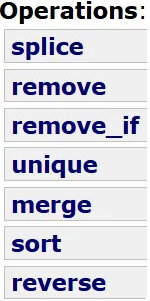
merge:2个链表归并。要先有序
unique:去重。要先有序
remove:find + erase。
splice:转移。把一个链表节点取下来,插入到另一个。
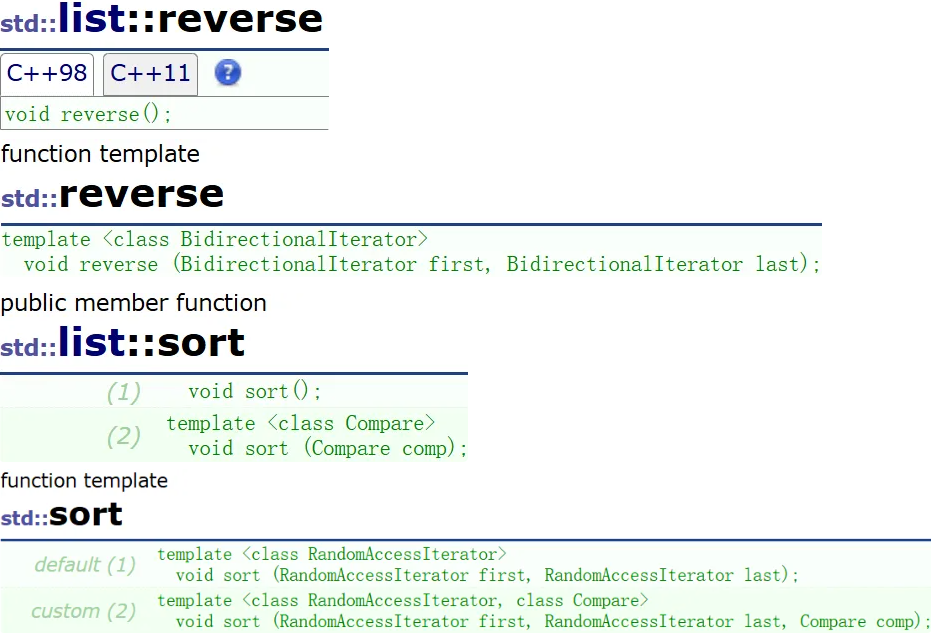
void test_list2()
{list<int> lt;lt.push_back(1);lt.push_back(2);lt.push_back(3);lt.push_back(4);lt.push_front(10);lt.push_front(20);for (auto e : lt) { cout << e << " "; }cout << endl;reverse(lt.begin(), lt.end()); // 算法库for (auto e : lt) { cout << e << " "; }cout << endl;lt.reverse(); // list自己的for (auto e : lt) { cout << e << " "; }cout << endl;//sort(lt.begin(), lt.end()); // 算法库//报错。sort是快排,要三数取中选位置,list无法适应这个场景for (auto e : lt) { cout << e << " "; }cout << endl;lt.sort(); // list自己的for (auto e : lt) { cout << e << " "; }cout << endl;
}迭代器
算法要作用到数据上面去,数据在容器里一般被封装为私有,不能直接访问
迭代器提供统一方式,让算法去处理容器中的数据,还不用知道容器底层是怎么实现的
把公共的算法提取出来
迭代器从功能、性质角度会分类,由容器底层结构决定
单向:++ forward_list/unordered_xxx
双向:++/-- list/map/set
随机:++/--/+/- vector/string/deque
上面容器能用的算法,下面容器也一定能用
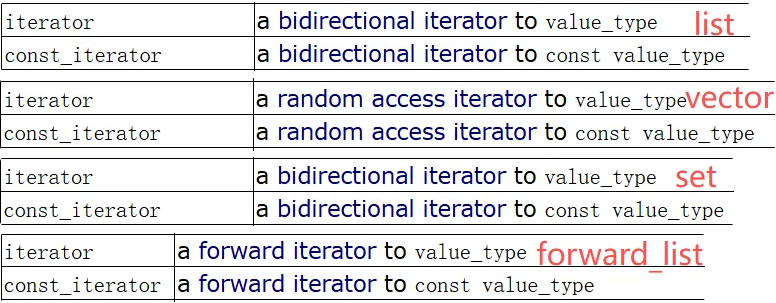
都是函数模板,但名字很有讲究,名字暗示要传什么迭代器、适合什么容器
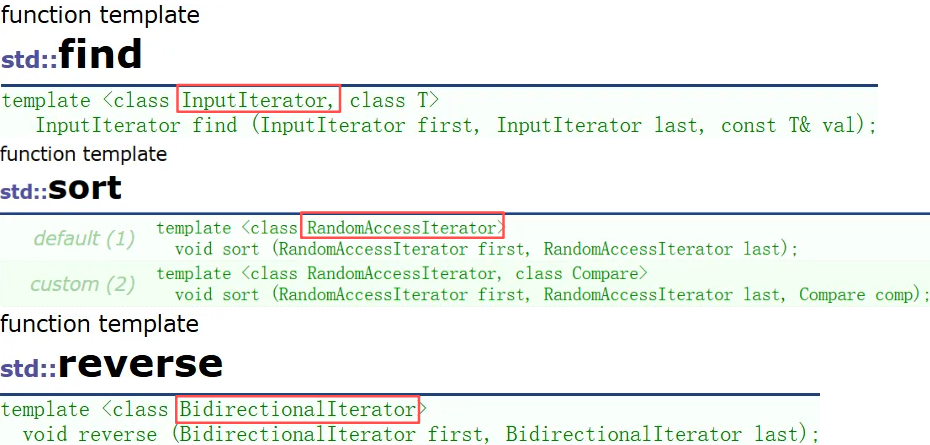
容器能不能用某个算法,要看容器的迭代器是哪一种,能不能适应算法
算法库里的 sort 要随机迭代器,所以 list 调就报错
所以 list 自己的 sort 就有意义了。但唯一意义是方便,数据量小可以用
数据量大不能用 list 排序,要用 vector 排序;vector 的效率 >> list 的效率
排序,要先把数据放在合适的容器再排序,而不是让 sort 算法兼容各个容器
如果兼容了反而误导了用户,用户在不知情的情况下会认为 vector、list 的 sort 没太大差别,导致效率下降
比如 vector 不直接提供头插头删,就是为了防止用户想大量头插头删时误用vector,导致效率下降
偶尔头插头删用 vector 没问题,大量头插头删就应该用 list
Release下:vector 的排序用算法的 sort(快排);list 的排序用 list 的 sort(归并)
void test_op()
{srand(time(0));const int N = 100000;vector<int> v;v.reserve(N);list<int> lt;for (int i = 0; i < N; ++i){auto e = rand();v.push_back(e);lt.push_back(e); }int begin1 = clock();sort(v.begin(), v.end());int end1 = clock();int begin2 = clock();lt.sort();int end2 = clock();printf("vector sort:%d\n", end1 - begin1);printf("list sort:%d\n", end2 - begin2);
}
拷贝到 vector 排序,排完以后再拷贝回来:↓
void test_op()
{srand(time(0));const int N = 5000000;list<int> lt1;list<int> lt2;for (int i = 0; i < N; ++i){auto e = rand();lt1.push_back(e);lt2.push_back(e);}int begin1 = clock();vector<int> v;v.reserve(N);for (auto e : lt1) // 先拷贝到vector{v.push_back(e);}sort(v.begin(), v.end()); // 排序size_t i = 0;for (auto& e : lt1) // 拷贝回去{e = v[i++];}int end1 = clock();int begin2 = clock();lt2.sort();int end2 = clock();printf("vector sort:%d\n", end1 - begin1);printf("list sort:%d\n", end2 - begin2);
}模拟实现
template<class T>class list{typedef list_node<T> Node;public:typedef Node* iterator; // 错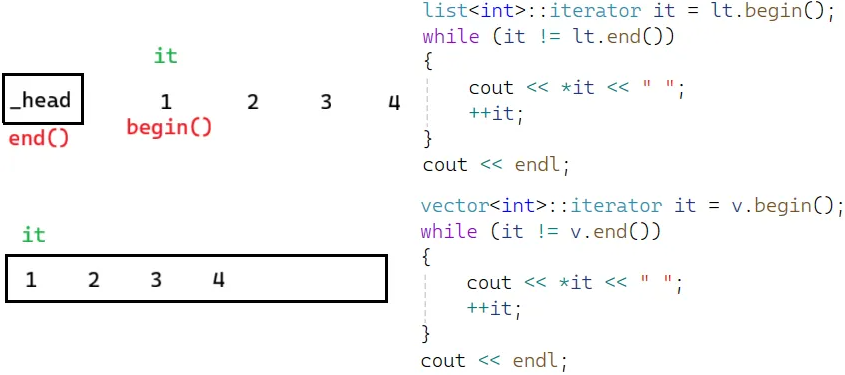
数组天生可以做迭代器,因为迭代器就是按数组指针的方式设计的。it 解引用拿到数据;++到下一个位置
不能让 Node* 充当 iterator,it 解引用得到的是节点,但想要的是数据;且++到不了下一个节点位置
库里用 __list_iterator类 封装节点的指针。相当于用一个节点的指针构造了一个迭代器
库里的迭代器是如何构造的?
迭代器是自定义类型,这个自定义类型的成员是一个节点的指针
其实这里本身想要的就是节点的指针,节点的指针就可以做迭代器。但由于底层的差异,像原生指针那样使用会报错,内置类型不符合我们的行为。
通过节点的指针可以找到下一个位置,达到 ++it 的效果;
通过节点的指针拿到 _val,达到 *it 的效果;
C++可以用一个类去封装这个内置类型,再重载运算符,改变原生指针 it 的行为:
*it 调用 operator* 函数;++it 调用 operator++ 函数
最终达成的效果:不论底层多么复杂,都可以和 vector 这种原生指针同一种用法
(上面说 vector 迭代器是原生指针只是为了理解 list 迭代器,任何容器的迭代器底层不一定是原生指针,不同平台会再封装。但所有容器最底层都是指针)
I 版代码
namespace qtw
{template<class T>struct list_node{list_node<T>* _next;list_node<T>* _prev;T _val;list_node(const T& val = T()):_next(nullptr), _prev(nullptr), _val(val){}};template<class T>struct __list_iterator{typedef list_node<T> Node;Node* _node;__list_iterator(Node* node):_node(node){}T& operator*(){return _node->_val;} // 出了作用域,节点还在,引用返回可读可写__list_iterator<T>& operator++(){_node = _node->_next;return *this;} // 自定义类型优先调用前置++__list_iterator<T> operator++(int){__list_iterator<T> tmp(*this);_node = _node->_next;return tmp;}bool operator!=(const __list_iterator<T>& it){return _node != it._node;}bool operator==(const __list_iterator<T>& it){return _node == it._node;}};template<class T>class list{typedef list_node<T> Node;// 这个Node不是给用户用的,是给类内部用的public:typedef __list_iterator<T> iterator;// 迭代器是对外用的iterator begin(){//return _head->_next;return iterator(_head->_next);}iterator end(){return _head;//return iterator(_head);}list(){_head = new Node;_head->_prev = _head;_head->_next = _head;}~list(){//...}void push_back(const T& x){Node* tail = _head->_prev;Node* newnode = new Node(x);tail->_next = newnode;newnode->_prev = tail;newnode->_next = _head;_head->_prev = newnode;}private:Node* _head;};void test_list1(){list<int> lt;lt.push_back(1);lt.push_back(2);lt.push_back(3);lt.push_back(4);list<int>::iterator it = lt.begin();while (it != lt.end()){(*it) += 1;cout << *it << " ";++it;}cout << endl;for (auto e : lt){cout << e << " ";}cout << endl;}
}问题1
iterator begin()
{//return _head->_next;return iterator(_head->_next);
}iterator end()
{return _head;//return iterator(_head);
}begin 为什么明明返回的是迭代器,却能返回节点的指针?
因为单参数的构造函数支持隐式类型转换。2种写法都是生成匿名对象
问题2
bool operator!=(const __list_iterator<T>& it)
{return _node != it._node;
}
///////////////////
list<int>::iterator it = lt.begin();
while (it != lt.end())
{cout << *it << " ";++it;
}
cout << endl;operator!= 不加 const 会报错,为什么加 const ?
调了 end(),是传值返回,返回的是 _head 的拷贝,是临时对象,常性
问题3
list<int>::iterator it = lt.begin();
while (it != lt.end())
{cout << *it << " ";++it;
}
cout << endl;第一行代码:调用 begin,返回值拷贝构造给 it
我们没写拷贝构造,默认生成的拷贝构造对内置类型完成浅拷贝。
没问题,要的就是浅拷贝
begin 返回指向1这个节点的迭代器,我们就希望 it 里面节点的指针也是指向1这个节点的迭代器
2个对象指向同一节点,没有析构2次,没有崩溃。
迭代器没写析构函数,因为节点不属于迭代器,节点应该由 list 释放
把节点给迭代器,不是让迭代器管理节点的释放……,只是借助这个节点访问容器
问题4:如何实现const迭代器?
template<class T>class list{typedef list_node<T> Node;public:typedef __list_iterator<T> iterator;// 这样设计const迭代器是不行的,因为const迭代器期望指向内容不能修改// 迭代器都要能++,要不然怎么遍历呢? 这样设计是迭代器本身不能修改typedef const __list_iterator<T> const_iterator; // 错// const T* ptr1;// T* const ptr2;private:Node* _head;};迭代器 与 const迭代器 唯一区别解引用操作 *it:↓
const T& operator*() // 返回 const T 的别名
{return _node->_val;
}T& operator*() // 返回 T 的别名
{return _node->_val;
}可以这样实现:↓
template<class T>struct __list_iterator{typedef list_node<T> Node;Node* _node;__list_iterator(Node* node):_node(node){}T& operator*() // 除了这,其他地方和 const迭代器一样{return _node->_val;}__list_iterator<T>& operator++(){_node = _node->_next;return *this;}__list_iterator<T> operator++(int){__list_iterator<T> tmp(*this);_node = _node->_next;return tmp;}bool operator!=(const __list_iterator<T>& it){return _node != it._node;}bool operator==(const __list_iterator<T>& it){return _node == it._node;}};template<class T>struct __list_const_iterator{typedef list_node<T> Node;Node* _node;__list_const_iterator(Node* node):_node(node){}const T& operator*() // 除了这,其他地方和普通迭代器一样{return _node->_val;}__list_const_iterator<T>& operator++(){_node = _node->_next;return *this;}__list_const_iterator<T> operator++(int){__list_const_iterator<T> tmp(*this);_node = _node->_next;return tmp;}bool operator!=(const __list_const_iterator<T>& it){return _node != it._node;}bool operator==(const __list_const_iterator<T>& it){return _node == it._node;}};template<class T>class list{typedef list_node<T> Node;public:typedef __list_iterator<T> iterator;typedef __list_const_iterator<T> const_iterator;iterator begin(){//return _head->_next;return iterator(_head->_next);}iterator end(){return _head;//return iterator(_head);}const_iterator begin() const{//return _head->_next;return const_iterator(_head->_next);}const_iterator end() const{return _head;//return const_iterator(_head);}private:Node* _head;};这么设计太冗余了,2个类只有 const T& operator*() 这里返回值不一样,我们通过一个类型控制这个返回值就行 ==> 增加一个模板参数
库里只设计了一个类,控制了3个模板参数去搞:↓
template<class T, class Ref, class Ptr>
struct __list_iterator {typedef __list_iterator<T, T&, T*> iterator;typedef __list_iterator<T, const T&, const T*> const_iterator;typedef __list_iterator<T, Ref, Ptr> self;
};template <class T, class Alloc = alloc>
class list {
public:typedef __list_iterator<T, T&, T*> iterator;typedef __list_iterator<T, const T&, const T*> const_iterator;
};II 版代码
我们本质上还是控制了2个类型。一个模板给不同的参数就是不同的类型
//typedef __list_iterator<T, T&> iterator;//typedef __list_iterator<T, const T&> const_iterator;template<class T, class Ref>struct __list_iterator{typedef list_node<T> Node;typedef __list_iterator<T, Ref> self;Node* _node;__list_iterator(Node* node):_node(node){}Ref operator*(){return _node->_val;}self& operator++(){_node = _node->_next;return *this;} // 自定义类型优先调用前置++self operator++(int){self tmp(*this);_node = _node->_next;return tmp;}bool operator!=(const self& it){return _node != it._node;}bool operator==(const self& it){return _node == it._node;}};template<class T>class list{typedef list_node<T> Node;public:typedef __list_iterator<T, T&> iterator;typedef __list_iterator<T, const T&> const_iterator;iterator begin(){//return _head->_next;return iterator(_head->_next);}iterator end(){return _head;//return iterator(_head);}const_iterator begin() const{//return _head->_next;return const_iterator(_head->_next);}const_iterator end() const{return _head;//return const_iterator(_head);}private:Node* _head;};库里重载了3个模板参数,还重载了一个运算符 ->
// 库里
reference operator*() const { return (*node).data; }
pointer operator->() const { return &(operator*()); }-> 的返回值是模板参数 Ptr,
运算符重载是可以显示调用的,所以可以调 operator*(),返回结果是 data 这个数据取地址
Ref operator*()
{return _node->_val;
}T* operator->()
{return &_node->_val;
}指针除了 *解引用,取指针指向的对象
还有 -> 解引用,如果是结构体的指针就要用 ->
迭代器又是模拟指针的行为,什么时候模拟结构体指针?链表数据是自定义类型:↓
struct A
{A(int a1 = 0, int a2 = 0):_a1(a1), _a2(a2){}int _a1;int _a2;
};void test_list2()
{list<A> lt;lt.push_back(A(1, 1));lt.push_back(A(2, 2));lt.push_back(A(3, 3));lt.push_back(A(4, 4));list<A>::iterator it = lt.begin();while (it != lt.end()) // 访问自定义类型数据{cout << *it << " "; // 流插入报错++it;}cout << endl;
}*it 解引用出来的数据是 T,这里是 A,是自定义类型。要求用户自己重载流插入,才能支持
如果 A 是私有的,只能去重载流插入。但现在是公有的,可以直接访问
cout << (*it)._a1 << " " << (*it)._a2 << endl;![]()
此时,迭代器模拟的是结构体指针,可不可以这样写?
cout << it->_a1 << " " << it->_a2 << endl;it 是自定义类型的指针,且上面重载了 ->,所以这样写没问题
但把 T* operator->() 屏蔽调代码会报错:“qtw::__list_iterator<T,T &>”类型没有重载成员“operator ->”

严格来说 it->->_a2 才符合语法
由于运算符重载要可读性,编译器省略了一个 ->,编译器自己知道有
const 迭代器这里要返回 const T *
const T* operator->()
{return &_node->_val;
}所以要加第三个模板参数
III 版代码
namespace qtw
{template<class T>struct list_node{list_node<T>* _next;list_node<T>* _prev;T _val;list_node(const T& val = T()):_next(nullptr), _prev(nullptr), _val(val){}};//typedef __list_iterator<T, T&, T*> iterator;//typedef __list_iterator<T, const T&, const T*> const_iterator;template<class T, class Ref, class Ptr>struct __list_iterator{typedef list_node<T> Node;typedef __list_iterator<T, Ref, Ptr> self;Node* _node;__list_iterator(Node* node):_node(node){}Ref operator*(){return _node->_val;}Ptr operator->(){return &_node->_val;}self& operator++(){_node = _node->_next;return *this;} // 自定义类型优先调用前置++self operator++(int){self tmp(*this);_node = _node->_next;return tmp;}bool operator!=(const self& it) const{return _node != it._node;}bool operator==(const self& it) const{return _node == it._node;}};template<class T>class list{typedef list_node<T> Node; // 这个Node不是给用户用的,是给类内部用的public://typedef __list_iterator<T> iterator; // 迭代器是对外用的//typedef __list_const_iterator<T> const_iterator; // 这么设计太冗余了typedef __list_iterator<T, T&, T*> iterator;typedef __list_iterator<T, const T&, const T*> const_iterator;iterator begin(){//return _head->_next;return iterator(_head->_next);}iterator end(){return _head;//return iterator(_head);}const_iterator begin() const{//return _head->_next;return const_iterator(_head->_next);}const_iterator end() const{return _head;//return const_iterator(_head);}list(){_head = new Node;_head->_prev = _head;_head->_next = _head;}~list(){//...}void push_back(const T& x){Node* tail = _head->_prev;Node* newnode = new Node(x);tail->_next = newnode;newnode->_prev = tail;newnode->_next = _head;_head->_prev = newnode;}private:Node* _head;};
}模拟实现最终代码
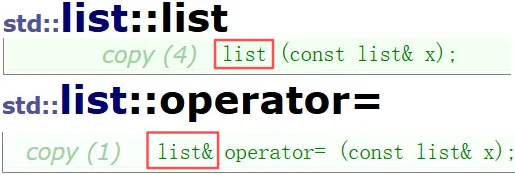
类模板在类里,类名可以代替类型。但我们不要这么写
namespace qtw
{template<class T>struct list_node{list_node<T>* _next;list_node<T>* _prev;T _val;list_node(const T& val = T()):_next(nullptr), _prev(nullptr), _val(val){}};//typedef __list_iterator<T, T&, T*> iterator;//typedef __list_iterator<T, const T&, const T*> const_iterator;template<class T, class Ref, class Ptr>struct __list_iterator{typedef list_node<T> Node;typedef __list_iterator<T, Ref, Ptr> self;Node* _node;__list_iterator(Node* node):_node(node){}Ref operator*(){return _node->_val;}Ptr operator->(){return &_node->_val;}self& operator++(){_node = _node->_next;return *this;} // 自定义类型优先调用前置++self operator++(int){self tmp(*this);_node = _node->_next;return tmp;}bool operator!=(const self& it) const{return _node != it._node;}bool operator==(const self& it) const{return _node == it._node;}};template<class T>class list{typedef list_node<T> Node; // 这个Node不是给用户用的,是给类内部用的public:typedef __list_iterator<T, T&, T*> iterator;typedef __list_iterator<T, const T&, const T*> const_iterator;iterator begin(){//return _head->_next;return iterator(_head->_next);}iterator end(){return _head;//return iterator(_head);}const_iterator begin() const{//return _head->_next;return const_iterator(_head->_next);}const_iterator end() const{return _head;//return const_iterator(_head);}void empty_init(){_head = new Node;_head->_prev = _head;_head->_next = _head;_size = 0;}list(){empty_init();}//list(const list& lt)list(const list<T>& lt){empty_init();// 自定义类型比较大的时候,范围for一定加引用for (auto& e : lt) {push_back(e);}}void swap(list<T>& lt){std::swap(_head, lt._head);std::swap(_size, lt._size);}//list& operator=(list lt)list<T>& operator=(list<T> lt){swap(lt);return *this;}~list(){clear();delete _head;_head = nullptr;}// 不删头结点void clear(){iterator it = begin();while (it != end()){it = erase(it);}_size = 0;}void push_back(const T& x){insert(end(), x);}void pop_back(){erase(--end());}void push_front(const T& x){insert(begin(), x);}void pop_front(){erase(begin());}// pos位置之前插入iterator insert(iterator pos, const T& x){Node* newnode = new Node(x);Node* cur = pos._node;Node* prev = cur->_prev;prev->_next = newnode;newnode->_next = cur;newnode->_prev = prev;cur->_prev = newnode;++_size;return newnode;}iterator erase(iterator pos){assert(pos != end());Node* cur = pos._node;Node* prev = cur->_prev;Node* next = cur->_next;prev->_next = next;next->_prev = prev;delete cur;--_size;return next;}size_t size(){/*size_t sz;iterator it = begin();while (it != end()){++sz;++it;}return sz;*/return _size;}private:Node* _head;size_t _size;};
}本篇的分享就到这里了,感谢观看,如果对你有帮助,别忘了点赞+收藏+关注。
小编会以自己学习过程中遇到的问题为素材,持续为您推送文章
